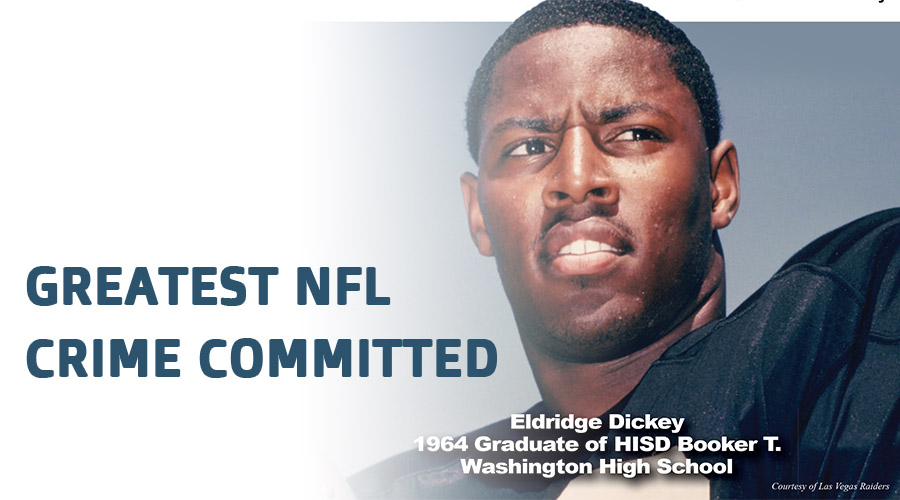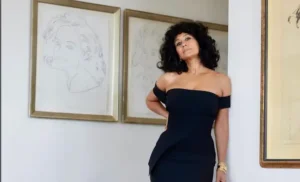By: Shelley McKinley
Born on Christmas Eve 1945, to a pastor and a nurse, it was fitting that Eldridge Dickey’s nickname would later become ‘The Lord’s Prayer.” He grew up in Independence Heights, the first Black town in Texas before it later became part of Houston’s Fourth Ward. While attending Lockett Junior High School in Houston, Dickey was quickly moved into the quarterback position in seventh grade, based on the speed and accuracy of the balls he returned during his brief stint as a wide receiver. Dickey became known among his junior high coaches as ‘The Boy with the Golden Arm.’
At Booker T. Washington High School in Houston, more people, including college scouts, got to see what Dickey’s junior high school coaches saw in him as a quarterback. He could throw with both hands, had arm strength, and possessed the speed of a track star. He also had an IQ in the 130s. As a result, Dickey was a standout among the Prairie View Interscholastic League and highly recruited to attend Tennessee State University (TSU). TSU won an intense recruiting battle for the highly decorated 6’2, 190 pound quarterback, who was known for his agility, quickness, and ambidextrous throwing ability. It was there at Tennessee State University, from 1965 to 1968, that he acquired his nickname ‘ e Lord’s Prayer.’ When he decided to attend Tennessee State University, he was given the nickname by head coach John Merritt. First, he was an answered prayer for the university’s football program. Dickey led Tennessee State to a perfect season in 1966 and the National Black College Football Championship. Second, Dickey led his team in prayer before every game.
CBS Sports reported that Former Tennessee State coach Joe Gilliam Sr. once said. “Our stadium would hold about 18,000 and at game time there would be about 30,000 people in here. Breaking every re code that you want to think about, but that’s the way they came. ey came from all over the country to see that young man, Eldridge Dickey, play.” In an era when teams were often scared to throw the ball, Dickey passed for 6,628 yards and 74 touchdowns in three seasons at Tennessee State. While Dickey was quarterbacking the Tigers, they put together a record of 34-5-1 in four years. Although two other Black men served as quarterbacks in the NFL, each with one appearance in the position, it was Eldrige Dickey that was the first Black quarterback to be selected in the first round of the January 1968 NFL/AFL Draft , making him the first black quarterback to be taken in the first round of any draft. Eldridge Dickey was the 25th pick in the first round by the Oakland Raiders for the quarterback position. He was signed to a deal worth $150,000 in four years. Prior to that, Charlie Brackens was drafted in the 16th round to the Green Bay Packers from Prairie View A & M University in 1955. Willie Thrower was not drafted but did have a one-year contract with the Chicago Bears.
Shockingly, the Oakland Raiders also chose Ken Stabler, a white player, as the 52nd pick in the 2nd round of the 1968 draft for the same quarterback position. When the 1968 Oakland Raiders roster was released, Ken Stabler was one of three quarterbacks, and Eldridge Dickey was one of six wide receivers. It was a 180 degree change in stance from what Dickey was led to believe during his last year at Tennessee State University. According to the Baltimore Sun (Sept. 2020), Al Davis, then general manager and part owner of the Oakland Raiders, repeatedly came to the university to scout Dickey. When asked by Coach Merritt if Dickey would get a fair shot at the quarterback position, Davis replied yes.
According to Vance Football Information (2006), compiled by NFL writer, researcher and historian Lloyd Vance, many wondered if Davis was looking to be a maverick and turn the team over to a Black quarterback or if he saw another athletic Black quarterback that needed to be converted. Other rumors stated that the Raiders wanted to keep Dickey away from their rival, the Kansas City Chiefs, who also had their eye on him. Chiefs Head Coach Hank Stram had been a master at finding gems at historically black colleges during this time as shown by his 1966 Super Bowl I losing squad, which featured HBCU players Emmitt omas, Bobby Bell, Fred Williamson and others. It is also unknown if this decision was influenced by the predominant stereotype at the time that Blacks weren’t intelligent enough to be capable leaders or if it was solely based on Dickey’s athletic ability. Despite the reason, this came as a blow to a player who at one time told his former coach, Joe Gilliam Sr., that if he couldn’t play quarterback he didn’t want to play. According to the Washington Post, Davis told Dickey that while he would not play quarterback his first year, he could compete for the backup position in future seasons, and was even given a jersey number reserved for quarterbacks, number 10. Dickey accepted the position hoping for an opportunity to play in the quarterback position.
Ms. LaCanas Casselle, college sweetheart and ex-wife of Dickey, shared on Genmaspeaks podcast (2014), that she and Dickey both majored in Health and Physical Education and bonded during their college experiences. She was a cheerleader and majorette while Dickey played football. They married in 1966. Shortly after the 1968 draft, they also experienced the death of Dr. Martin Luther King, Jr. together. During that time, Dickey flew to Houston to share those experiences with his mother and flew his wife to Houston. He bought a home for his mother and took his wife on shopping sprees to Neiman Marcus. He wanted them to share in his good fortune. Dickey’s daughter, Shaun Casselle, shared during her interview on Genmaspeaks that Dickey carried the hopes and dreams of his former coaches and fellow HBCU football players as well as his own. “He wanted to be the first Black man to start as an NFL quarterback. Not playing in the quarterback position was truly a dream deferred. America wasn’t ready for him,” lamented Casselle Ironically it was Marlin Briscoe, who was taken in the 14th round of the same 1968 draft by the Denver Broncos (AFL) as a defensive back, who broke through as the first black starting quarterback setting Broncos’ rookie records of 1,589 yards passing with 14 touchdowns. Briscoe, too, was later converted to wide receiver after his one season as a quarterback. Briscoe later won two mi Dolphins teams of the early 1970’s.
Briscoe, who is credited as being the first black starting quarterback in the NFL, wrote in the book, ‘ ird and a Mile: e Trials and Triumph of the Black Quarterback’ that Dickey was “An exceptional athlete, who was too good of a quarterback, at a time when society was not ready for him”. Briscoe wrote that Dickey came to his apartment when the Raiders played the Broncos in Denver and that he could see that Dickey was despondent over the position change. He said, “You could see from his body language that the position change was not sitting well with him.” Briscoe added “To be honest with you, he should have been the first black quarterback to start.”
What began as a promising NFL career full of hope in 1968, took a turn. It is believed that the position change affected Dickey’s performance on the field. He made just one catch for 34 yards and 6 punt returns for 48 yards in 11 games in the 1968 season. John Madden took over as coach of the Oakland raiders in 1969. According to the Washington Post, the night before the Raider’s pre-season game against the Chiefs in Birmingham, Stabler quit the team. His opportunity opened the door for Dickey. e Raider’s planned to let Dickey start the second half of the game, but quarterback Daryle Lamonica hurt his throwing hand in the second quarter. With Stabler watching from the stands, Dickey went in, and wound up running for a 20-yard touchdown. Later in the game he threw three interceptions and fumbled, but kept the Chiefs guessing with his spontaneity. Dickey went on to connect with wide receiver Rod Sherman in the end zone for a potential game-winning score, but Sherman stepped out of bounds and the Raiders lost 23 – 17. Dickey was praised for scrambling by the Chief ’s coach Stram, but dismissed by the Raider’s coach Madden saying, “We prefer our quarterbacks to drop back and throw the ball.”
Dickey had one other opportunity to play in the quarterback position the next week against Baltimore, throwing for 74 yards and rushing for another 26. However, when Stabler returned in 1970, Dickey was asked to go back to wide receiver for good. His ex-wife Casselle, who separated from Dickey before his time with the Raiders ended, stated “He always felt like, ‘If I can’t play quarterback, there goes my dream.’ It hurt so much. It changed his whole personality.” Dickey began to skip practices and disappeared for two weeks in 1970, the second season in which he never saw the field.
He didn’t play in another game until 1971 where he made four catches for 78 yards with one touchdown and was cut from the team seven games into the season after dropping a pass against the Kansas City Chiefs that could have been a touchdown. It was a huge drop in a 20-20 tie against the Chiefs on Oct. 31, 1971. e Raiders waivered Dickey, but rescinded the waiver request when the Chiefs claimed him. Later, Madden kicked Dickey off the team in December. e Oakland Raiders traded Dickey to the Baltimore Colts in 1972. The Colts then shipped him to the Kansas City Chiefs. Coach Stram, who twice tried to get Dickey said later, “What happened to Eldridge Dickey has to go down as one of the greatest sports crimes ever committed. the entire sports world was robbed by the Oakland Raiders.” Dickey’s one season with the Chiefs gave him the ve years of service needed for his pension.
In an interview with the Kansas City Star, Dickey explained, “Everybody wants to call a man a criminal, but no one asks him why he became one. When you want something for so long, when you put out and think you have earned it – and then have it taken away from you, your desire dies. Mine did.” Dickey’s game was more suited for 21st-century football and would have been applauded today. Quoted in the Baltimore Sun, “He would have been a star,” said James (Shack) Harris, who played against Dickey in college and later became the first Black player to start a season at quarterback. “He had pocket awareness and the ability to scramble and run. He was fast. there was nothing that he couldn’t do.”
Recognition escaped Dickey while he was alive, but has occurred over the years. Most recently, Houston ISD included Eldridge Dickey, along with 15 other individuals and a team, into its 2021 inaugural class of the HISD Athletic Hall of Honor. Dickey was also posthumously inducted in the Black College Football Hall of Fame, as well as the Tennessee Sports Hall of Fame. His ex-wife, daughter and grandson, Brayden Dickey, were present in Nashville, TN for his induction to the Tennessee Sports Hall of Fame. Brayden Dickey accepted his grandfather’s Sports Hall of Fame ring on Eldridge Dickey’s behalf. Eldridge Dickey died on May 22, 2000, at age 54. He is buried at Paradise North Cemetery in Houston, TX.







